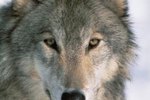Gray wolves - along with red wolves - were declared endangered in 1973. At this time, the Endangered Species Act was passed, which gave gray wolves federal protection. Thanks to this protection, wolf populations are increasing in numbers in the northern Rockies, Great Lakes and the Southwestern United States. Despite some controversy, gray wolves were taken off the endangered species list in some states in 2008.
Threats
Gray wolves have often lived under persecution; they came into conflict with humans because they preyed on livestock. And, in the early 20th century, the government led a massive extermination campaign against wolves. Humans have also encroached into wolf territory, causing wolves to lose their natural habitat. These problems caused the number of gray wolves to decline drastically, leading them to become an endangered species.
Endangered Species Act
The Endangered Species Act is a program that protects threatened natural species. It protects everything from birds and mammals to insects and trees. Under the act, federal agencies must consult with the U.S. Fish and Wildlife Service to ensure they do not authorize actions that would jeopardize endangered species. Gray wolves were placed on this list in 1973, because, at the time, there were only 500 wolves in the United States.
Effect of The Endangered Species Act
The protections of the Endangered Species Act have helped to re-establish the populations of gray wolves throughout the United States. To further boost population numbers, in the mid-1990s wildlife specialists brought Canadian wolves to parts of Montana, Idaho and Wyoming as well as Yellowstone National Park, an area where wolves were once entirely eliminated. Because restrictions prevent hunters from killing deer and elk in these areas, there is plenty of wildlife for the wolves to eat. Thanks to these efforts, there are currently about 5,000 gray wolves living in the lower states and between 7,000 and 11,000 in Alaska.
Controversy
Due to rising livestock casualties, the wolves were taken off the endangered species list in five states: Idaho, Montana, Wisconsin, Michigan and Minnesota. While federal scientists have said that the population of the wolves is stable, conservationists insist their numbers aren’t strong enough to be off the list. Wolf hunting has been legalized in Idaho and Montana; during the case, a federal judge justified his decision by citing a study that indicates that the wolves could lose 30 percent of their population and still recover.
References
Photo Credits
-
Jupiterimages/Photos.com/Getty Images
Writer Bio
Katherine Hartman started writing professionally in 2008, covering topics such as film, theater architecture and environmental issues. She has contributed to "Cleveland Magazine," "Southeast Ohio Magazine" and "Building Design and Construction" magazine, among other publications. Hartman graduated from Ohio University's E.W. Scripps School of Journalism in 2008 with a Bachelor of Science in journalism.





